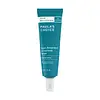What's inside
What's inside
 Key Ingredients
Key Ingredients

 Benefits
Benefits

 Concerns
Concerns

 Ingredients Side-by-side
Ingredients Side-by-side

Cyclopentasiloxane
EmollientIsododecane
EmollientDimethicone Crosspolymer
Emulsion StabilisingNeopentyl Glycol Diheptanoate
EmollientCyclohexasiloxane
EmollientCaprylic/Capric Triglyceride
MaskingTocopheryl Acetate
AntioxidantRetinyl Palmitate
Skin ConditioningRetinol
Skin ConditioningTetrahexyldecyl Ascorbate
AntioxidantAstaxanthin
Skin ConditioningBisabolol
MaskingChamomilla Recutita Flower Extract
MaskingCamellia Sinensis Leaf Extract
AntimicrobialSalix Alba Bark Extract
AstringentVitis Vinifera Seed Extract
AntimicrobialGinkgo Biloba Leaf Extract
Skin ConditioningCalluna Vulgaris Flower Extract
Skin ConditioningVaccinium Macrocarpon Fruit Extract
AstringentRubus Idaeus Fruit Extract
AstringentBetula Alba Bark Extract
MaskingGlycine Soja Oil
EmollientSilica
AbrasivePhenoxyethanol
PreservativeCyclopentasiloxane, Isododecane, Dimethicone Crosspolymer, Neopentyl Glycol Diheptanoate, Cyclohexasiloxane, Caprylic/Capric Triglyceride, Tocopheryl Acetate, Retinyl Palmitate, Retinol, Tetrahexyldecyl Ascorbate, Astaxanthin, Bisabolol, Chamomilla Recutita Flower Extract, Camellia Sinensis Leaf Extract, Salix Alba Bark Extract, Vitis Vinifera Seed Extract, Ginkgo Biloba Leaf Extract, Calluna Vulgaris Flower Extract, Vaccinium Macrocarpon Fruit Extract, Rubus Idaeus Fruit Extract, Betula Alba Bark Extract, Glycine Soja Oil, Silica, Phenoxyethanol
 Reviews
Reviews

Ingredients Explained
These ingredients are found in both products.
Ingredients higher up in an ingredient list are typically present in a larger amount.
This ingredient is an emollient, solvent, and texture enhancer. It is considered a skin-softener by helping the skin prevent moisture loss.
It helps thicken a product's formula and makes it easier to spread by dissolving clumping compounds.
Caprylic Triglyceride is made by combining glycerin with coconut oil, forming a clear liquid.
While there is an assumption Caprylic Triglyceride can clog pores due to it being derived from coconut oil, there is no research supporting this.
Learn more about Caprylic/Capric TriglycerideGlycine Soja Oil comes from the soybean. Glycine Soja is native to eastern Asia.
Soybean oil is an emollient. It is rich in antioxidants and fatty acids including palmitic, stearic, oleic, and linoleic acids.
As an emollient, the fatty acids in soybean oil helps keep your skin soft and hydrated. It does so by creating a film on top that traps moisture in.
Soybean oil is also rich in vitamin E, a potent antioxidant. Vitamin E is also anti-inflammatory and provides a soothing effect.
Studies show soy may help fade hyperpigmentation from UVB. It does so by disrupting the melanin process from UVB induced skin inflammation.
This ingredient may not be malassezia folliculitis, or fungal-acne, safe.
Soybeans are rich in proteins and are part of the legume family. Foods made with soybeans include tofu, soymilk, edamame, miso, and soy sauce.
Learn more about Glycine Soja OilRetinol is a gold-standard ingredient for anti-aging. It is a form of Vitamin A and belongs to the class of retinoids that also includes tretinoin.
Why is retinol famous?
It has the most scientific studies backing up its skin benefits out of all the non-prescription ingredients.
Retinol is proven to:
This is why retinol is effective at removing wrinkles, fading dark spots, treating acne, and reducing the appearance of pores.
Studies show retinol is less effective when exposed to UV. Be sure to look for appropriate packaging to keep your retinol potent (similar to Vitamin C).
Using retinol or any retinoids will increase sun-sensitivity in the first few months. Though studies show retinoids increase your skin's natural SPF with continuous use, it is best to always wear sunscreen and sun-protection.
We recommend speaking with a medical professional about using this ingredient during pregnancy.
Retinol may cause irritation in some people, so be sure to patch test. Experts recommend 'ramping up' retinol use: start using this ingredient once a week and work up to using it daily.
Read about Tretinoin
Learn more about RetinolSilica, also known as silicon dioxide, is a naturally occurring mineral. It is used as a fine, spherical, and porous powder in cosmetics.
Though it has exfoliant properties, the function of silica varies depending on the product.
The unique structure of silica enhances the spreadability and adds smoothness, making it a great texture enhancer.
It is also used as an active carrier, emulsifier, and mattifier due to its ability to absorb excess oil.
In some products, tiny microneedles called spicules are made from silica or hydrolyzed sponge. When you rub them in, they lightly polish away dead skin layers and enhance the penetration of active ingredients.
Learn more about SilicaTocopheryl Acetate is AKA Vitamin E. It is an antioxidant and protects your skin from free radicals. Free radicals damage the skin by breaking down collagen.
One study found using Tocopheryl Acetate with Vitamin C decreased the number of sunburned cells.
Tocopheryl Acetate is commonly found in both skincare and dietary supplements.
Learn more about Tocopheryl Acetate